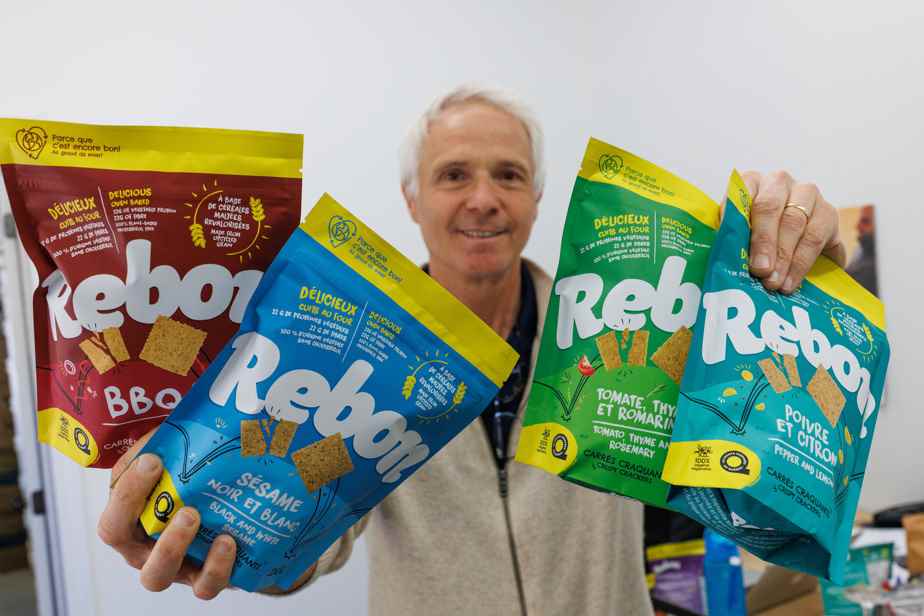In October, we present local companies that innovate by offering new and ingenious products. Today: Rebon circular economy crackers.
Posted October 26
The idea
French by origin, Patrick Mougin worked for multinational agri-food companies, notably in Dubai, before landing in Quebec 12 years ago. “We have four children, my wife and I, and we were looking for a new place to settle. We did a house swap with a Quebec family from Rawdon for a year. We liked it so much that we bought the house next door and we never left! »
Determined to own his own business, he founded the Malstrom microbrewery eight years ago in Notre-Dame-des-Prairies. Who says beer production says spent grain, a brewing by-product made up of malt residue. “Draff is used in animal feed, but it is not the best use that can be made of it. It contains fibers, proteins, mineral salts, heaps of interesting things for human food. It’s also an area that we don’t have to cultivate again,” he notes.
But how to reuse and revalorize this residue? The idea came from Jean-David Camus, a French associate of Mr. Mougin, who one day arrived from France with crackers made from spent grain. “The taste wasn’t more famous than that, but the idea sprouted from there! “, he recalls.
The challenge

PHOTO PROVIDED BY REBON
Fresh spent grains are like very moist oatmeal.
The first step was to figure out how to turn this brewing residue into an attractive product. The entrepreneur first had feasibility studies carried out by Cintech, an agri-food research and development institute in Saint-Hyacinthe, then rented premises in La Boîte à Startup, in Berthierville, in order to be able to test his recipes with equipment adapted to their needs. Fresh draff, which Mr. Mougin compares to “very moist and hot oatmeal”, is far from being an easy product to handle and process. Some companies will dry it and then grind it into flour, an energy-intensive process that goes a little against the principles of upgrading, believes the entrepreneur. It is therefore necessary, ideally, to use the spent grain as soon as it leaves the tanks. But you have to act quickly, otherwise spontaneous fermentation takes place, which must absolutely be avoided, otherwise the product will deteriorate. “The logistical challenge is there. »
innovation
The solution found by Mr. Mougin is quite simple, but requires, as we have said, impeccable logistics. The spent grain is collected directly from his brewery and brought immediately to the factory he opened in 2020, in Saint-Ambroise-de-Kildare. The raw material is crushed, then cooled, which leaves a few days of respite. When it is time to go into production, the spent grain will be kneaded with the other ingredients used in the composition of the crackers, then the dough thus obtained will be rolled with a machine used manually, placed on a plate, cut and finally put in the oven. . “Strenuous manual activities” that will soon be replaced by another innovation, a fully automated machine that the owner has custom designed, according to his needs, with a Quebec manufacturer.
We cannot imagine mass production, democratizing the revalorization of a residue with so many manual operations.
Patrick Mougin, from Rebon
From the five tons of spent grain used since the launch of the Rebon brand in June 2021, the company hopes to increase to a hundred tons revalued per year with this new equipment.
The result
-

PHOTO HUGO-SÉBASTIEN AUBERT, THE PRESS
The dough consisting of crushed grains, flour, canola oil and spices, ready to be made into crackers.
-

PHOTO HUGO-SÉBASTIEN AUBERT, THE PRESS
The dough is ready to pass through the rolling mill.
-

PHOTO HUGO-SÉBASTIEN AUBERT, THE PRESS
Roll out the dough to flatten it into a thin layer.
-

PHOTO HUGO-SÉBASTIEN AUBERT, THE PRESS
The crackers are cut by hand, but a new automated machine will soon take over this task.
-

PHOTO HUGO-SÉBASTIEN AUBERT, THE PRESS
Crackers, ready to be baked
-

PHOTO HUGO-SÉBASTIEN AUBERT, THE PRESS
And hop ! In the oven for a dozen minutes.
-

PHOTO HUGO-SÉBASTIEN AUBERT, THE PRESS
The crackers are ready to be packaged.
-

PHOTO HUGO-SÉBASTIEN AUBERT, THE PRESS
The end product
1/8
With his Rebon crackers (“because it’s good again”), Patrick Mougin not only wanted to revalue a food by-product, he also wanted to offer a healthy and gourmet product, prepared with a limited number of ingredients. Dregs from cereals such as barley, rice, oats or buckwheat remain the star ingredient of crackers, to which are added flour, canola oil and, depending on the variety, spices, garlic, sesame or poppy seeds. In all, Rebon markets six varieties without dyes or additives, with 100% plant-based ingredients. In addition to being distributed in supermarkets, delicatessens and online platforms such as Lufa and Maturin, Rebon also has CPE customers, who buy its product in bulk, and hopes to attract the hospital environment and residences for the elderly. . The next challenge: stand out in a highly competitive market, which Rebon hopes to do with its product identified as circular economy, at a reasonable price of $4.99 for 150g.
Our opinion

PHOTO HUGO-SÉBASTIEN AUBERT, THE PRESS
Black and white sesame crackers
Baked, Rebon Square Crackers are very thin and crunchy, without being greasy to the touch. As they are healthy (low fat, salt, good fiber content…), you don’t feel guilty for eating several of them. Because yes, they taste very good, especially with dips, hummus or cheese. We really liked the chipotle and poppy seed varieties, the bagel inspiration, the black and white sesame. A great nutritious product for the whole family.

